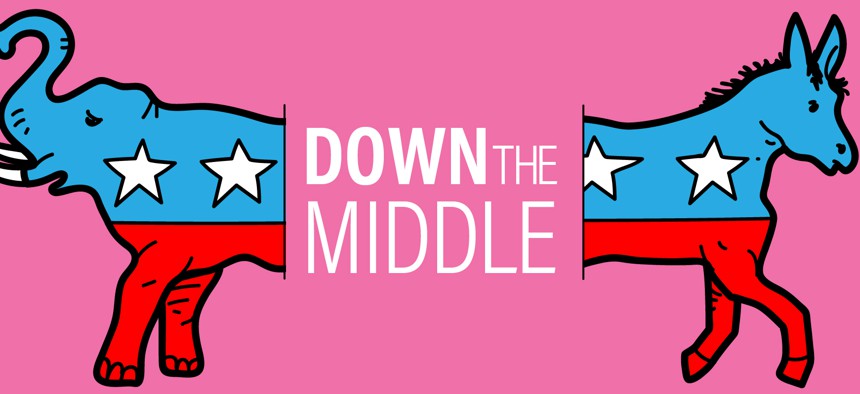Andrew Cuomo
Which party would really benefit from Cuomo’s voting reforms?
So if Republicans block Cuomo’s election reform proposals making it easier to vote, they may be protecting their party but losing an opportunity to make politics less divisive.

A donkey and an elephant split by the words "down the middle" Illustration by Guillaume Federighi/City & State
If you’re wondering why Gov. Andrew Cuomo’s proposed voting reforms have gone nowhere in years past, the first answer might be that Republicans control the state Senate. Throughout the country, Democratic legislatures try to make voting easier, and thereby expand the electorate, while Republicans make it harder. In recent years, many Republican-controlled state legislatures have passed strict voter identification requirements that studies show disenfranchise racial minorities. Meanwhile, some Democratic-controlled states have enacted reforms that Cuomo is advocating for: automatic voting registration, Election Day registration and early voting.
Both parties are acting on the assumption – which is widespread among journalists, political activists and elected officials – that larger turnout benefits Democrats. But is it true? The data provides a more nuanced view: Nonvoters or occasional voters do not necessarily fall to the left. Adjusted for demographics, they tend to cluster more toward the middle of the ideological spectrum than regular voters, who are often highly motivated by strong political convictions or partisanship.
Former nonvoters are also more likely to register without a party and to swing back and forth between parties when they do vote. When states ease voting requirements, “most of the new registrants are nonaffiliated voters,” said Michael P. McDonald a political science professor at the University of Florida. “The result is decreasing partisanship of the electorate.”
This isn’t just an abstract claim from the ivory tower: States that have facilitated voting with measures like automatic voter registration – including Oregon, Colorado and Illinois – have seen turnout go up with no increased advantage for Democrats. Since 2014, blue Oregon and Illinois as well as purple Colorado elected Republicans statewide: U.S. Sen. Cory Gardner in Colorado, Gov. Bruce Rauner in Illinois and Secretary of State Dennis Richardson in Oregon. “My sense is that the political scientists are right and that no party explicitly benefits,” a longtime voting rights advocate in multiple states said in an email to City & State, requesting anonymity to avoid interfering with current issue campaigns. “The folks added to the system through these reforms have very low partisan identity, so even though they are younger and more racially diverse – although they’re also more rural – these voters tend to be up for grabs.”
That’s why some experts said increasing voter turnout won’t help one party over another. In 2014, the political analysis website Of Politics And Men took on this question and reached the following conclusion: “Much empirical research suggest that increased voter turnout does not necessarily benefit the Democrats.” The best known work on the subject, a 1980 article by James DeNardo in The American Political Science Review, found that Democrats benefit from higher turnout, on average, but not in Republican wave elections. DeNardo argued that regular voters skew Republican, while “peripheral voters,” who lean Democratic, have weaker party identifications and are more likely to defect from their party.
Things have changed since 1980, though. Voting behavior has become more closely correlated with race and age, for example. While marginal voters are more moderate than reliable voters, when adjusted for race, they still might lean Democratic just because of who they are. Especially in the divided age of President Donald Trump, adding lower-income, younger and nonwhite New Yorkers to the voting rolls may help Democrats win elections.
Some more recent studies have shown a big benefit to Democrats from a larger electorate. A 2015 journal article by University of Chicago public policy professor Anthony Fowler found a significant advantage to Democrats from higher turnout. “Marginal voters are over 20 percentage points more supportive of the Democratic Party than regular voters,” Fowler wrote.
“In a two-party system, having more moderate voters does not necessarily mean you have a lower percentage who are going to cast their votes for a D as opposed to an R,” said Daniel Tokaji, a professor of election law and constitutional law at Ohio State University. If Democratic-leaning states like New York ease voting requirements, the result could, paradoxically, both help Democrats while increasing moderation and easing partisan rancor. “If I had to bet,” Tokaji said, “I’d bet that you have more moderate voters and slightly more Democrats than Republicans added.”
So if Republicans block Cuomo’s proposal, they may be protecting their party but losing an opportunity to make politics less divisive.
NEXT STORY: Why Uber is in favor of congestion pricing

